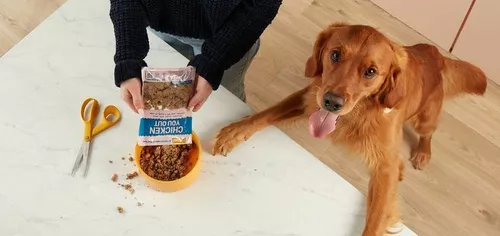Best Ways to Serve Butternut Box
- 01 Aug 2023
- 7m read

Fresh From the Fridge
After choosing a pouch from the fridge (your dog can help you decide which one) the next step is getting it open. There is some controversy amongst the Squad and our fellow Butternutters over the best way to do this. Our founder, Dave, thinks that this is the best way to open a pouch. Do you agree?
We'll give you a daily guideline amount for your pup and it's up to you how you feed this. Most pet parents tend to split this into two meals a day, one in the morning and one in the evening. You can store the pouch in a Tupperware box until teatime to keep it fresh, or simply wrap it in cling film.
Recommended Feeding Tips
At Butternut Box, we put the health and happiness of dogs first, always. We want to make sure that each and every pooch is getting the most out of their meals. Now, we will be surprised if your dog doesn't make a B-line for their food as soon as it's served up, but on the off-chance that they don't, there's a few things you can do to make dinner time even more delightful.
Stick to a routine
Research has shown that dogs thrive on routine. Repeating the same patterns each day will help provide your dog with cues of what is going to happen next and how they should behave.
This helps them to feel safe, secure, and relaxed, which should encourage them to eat. With that in mind: stick to the same type of food for at least a few weeks before changing to something new, and when trying any of following tips, be sure to try them one at a time for at least one week, to give your pup time to adapt.
The 20 minute rule
Try a new routine (for at least a week) where you put your dog's meal down for 20 minutes. If they don't eat it, lift the bowl and take the food away until it is their next meal time. It's important to leave them to it and not give them any attention for the duration of the 20 minutes when the bowl is down.
This is because when you try to encourage your dog to eat, it can actually reinforce the not-eating behaviour, and they might start to learn that they get more attention if they don't eat than if they do.
Walk the walk
Dogs are more likely to eat their meals after a period of exercise such as a walk or some playtime. Try following your daily walks with a meal so that your dog knows when to expect their food and will have worked up an appetite to eat. Having a set routine and feeding meals at the same time each day will also help your dog to regulate their digestion. This new routine could take a few days to have the desired impact, so stick with it for at least a week.
Make mealtimes fun
Some dogs prefer to work for their meal rather than have it (literally) served on a plate for them. This can vary from breed to breed, but it might be worth trying out an interactive feeding product like a Lickimat or puzzle feeder, to see if this makes mealtimes more fun. Think of it like the pooch equivalent of dinner and a show.
Mix it up
Just like us humans, dogs enjoy variety in their meals - it is the spice of life, after all. If they’re getting the exact same food every day, they may become bored and disinterested. Try mixing up the meal selections in your next box to see if they find a new favourite - just be sure to give each new variety a decent chance (a good week or two) before moving onto a new one.
Bring the heat
Warming our meals is a tried-and-tested method for many Butternutters. In fact, some pampered pooches are so used to having their meals slightly warmed that they can't have it served any other way now. When we say our pups eat better than us, we really mean it.
This can be done easily by popping our meals in the microwave on a low heat for a minute or so. Alternatively you can place the pouch in a bowl of hot water or drizzle a bit in over their meal. Heating the food emphasises the delicious aromas and makes them utterly irresistible to pooches.
Is Your Dog Turning Their Nose Up?
A whopping 44% of dogs are fussy with their food* and certain breeds are more likely to be fussy than others, particularly poodle mixes and small breeds**. That said, we know that dealing with a fussy pup can be challenging, or even worrying sometimes. You might be concerned they’re not getting enough nutrition, or that they won’t grow up to be their happiest and healthiest without a full belly everyday.
These are all valid concerns, but don’t dismay - you’ve come to the right place. At Butternut, we feed plenty of discerning dogs with picky palates. In fact, 52% of the dogs we feed were fussy when they first signed up. So you’re in safe hands (and paws).
If you need a little help getting your dog to tuck in, here are some top tips from Dr Ciara, our in-house vet and research specialist in this area, for encouraging your dog to eat their food more enthusiastically.
Make sure that they're comfortable
Did you know that where your dog eats can be just as important as what they eat?
The kitchen is a popular spot, but it can be a loud and distracting place for eating when you’re a dog. Try serving up in a quieter room, or even swapping their usual bowl for a different dish, to create a new environment that they might be more comfortable with.
Folder dogs or those with painful conditions such as arthritis, remember that eating on a tiled or wooden floor can be like trying to eat your dinner on a skating rink after you've sprained your ankle - not ideal. Pop a rug underfoot to make it less slippy and easier for them to eat. Raising the bowl can be hugely helpful too, minimising the strain on their neck, shoulders and elbows.
Tone down the treats
Initially eliminating treats between meals (or only feeding 1-2 within the 30 minutes after they've eaten a meal) until your dog is eating all of their meals at the right time will help them to build an appetite. This should lead to more successful meal times and more empty bowls. Once your dog is eating well, you can gradually re-introduce treats as part of their daily rewarding routine.
Stop with the scraps
Whilst it may seem harmless, feeding your dogs scraps of your leftover food can make them really fussy. Not to mention that it's likely to contain ingredients, such as onions and garlic, which are toxic to dogs. No matter how delicious Butternut Box may be, if there's hope of some leftover lasagne why would they leave any room for their own food? We really can't stress this one enough. You should also keep any waste bins out of their reach incase they decide to go scavenging.
Lose the lemon
Finally, a handy cleaning tip to keep in mind: some dogs don't like citrus scents, so using a lemony washing up liquid to wash their bowls could possibly be why they aren't eating their food, as the scent may be overpowering. Switch to non-scented soaps and see what happens.
Transition Period
If you're new to Butternut, it is really impawtent to make sure that you're making the change gradually to prevent unwanted upset tummies. You can read all you need to know about successfully transitioning here.
Time to Dig In
We hope these ideas have been helpful. If you’d like more personalised advice, you can book in a call to our dedicated Fussy Eater Helpline to speak to one of our experts whenever you need.
And you can of course check out our handy Help Centre or contact our Customer Love team if you have any other questions about your boxes. We’re always happy to help.
*Based on a survey of 2,509 dog parents in the UK.
**From an in-house statistical analysis of >220,000 dogs.

.webp)


